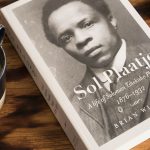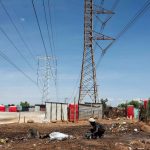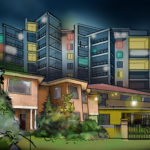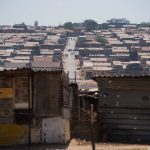Taking Joburg from division to inclusion
South Africa’s biggest city stretches over the horizons, instead of into the skies above it. New policies offer part of the solution to this apartheid hangover.
Author:
18 March 2019

Johannesburg is a bloated city. A monument to the private motor vehicle, it stretches for mile on sparsely populated mile.
This urban sprawl is born of colonial and apartheid planning, and the short-sighted housing policies and predatory development that followed.
It is a leach on the people who call Johannesburg home, driving the city’s world-leading inequality, poisoning the air its residents breathe, and barricading its impoverished black communities from the economic, social and political benefits of city life.
Densifying Johannesburg has become as much a moral imperative as a pragmatic one. Without it, the city’s future will be even bleaker than its violent and oppressive past.
A clutch of legislative developments has opened a narrow window of opportunity to slow Johannesburg’s crippling sprawl. But propertied interests in the city’s affluent neighbourhoods are staging considerable resistance against this glimmer of hope.
Both history and the facts are against them.
‘Swart gevaar’
At the end of the 19th century, dubious allegations of rapes of white women by black men sowed the racist seeds that eventually blossomed into the modern sprawl of South Africa’s cities. At the same time similar claims were exploited for a similar purpose in the United States.
Responding to one of these allegations, authorities in Durban and Pietermaritzburg imposed a system that required black people to register and wear an identifying badge, known colloquially as the “dog badge”, to access the city.
Die swart gevaar or “black peril” – the colonial trope about the vulnerability of white women in the face of black men – took root in Johannesburg as well. Eventually, it served as an ideological underpinning to the 1923 Urban Areas Act. “Brutal” black men had to be kept distant to ensure the safety of “virtuous” white women.
The Urban Areas Act (the blueprint for which, the 1913 Land Act, relegated the black majority to 7% of the country’s land) codified the non-permanence of black people in South Africa’s “white” cities. Their relegation to peripheral townships was further entrenched by apartheid’s city planners. Here, black people were out of sight and mind, but near enough to do the work that sustained cities.
Related article:
One result of this history is a sporadically populated city that now spreads across the Witwatersrand like too little butter over too much toast.
Only 2 696 people live in every km2 of Johannesburg. That is dwarfed in sister cities on the continent (18 150 people per km2 in Lagos) and the global south (28 508 people per km2 in Mumbai, 9 000 people per km2 in Sao Paulo).
Even the great cities of Europe (21 498 people per km2 in Paris) and America (10 431 people per km2 in New York) are considerably more dense than Johannesburg.
Low density has drastic consequences for Joburgers. In cities like London or Copenhagen, for instance, more than one in every two people live less than 1km from their nearest transport facility. Only one in every 10 people living in Johannesburg enjoys that level of access.
An endless present
Our urban sprawl is not only an inheritance of racist legislation that aimed to keep black people out of South African cities. It is also a living nightmare for the impoverished people living in our cities today. While the curse of Johannesburg’s sprawl was encoded before and during apartheid, it has continued under policies enacted since the end of white minority rule.
The unprecedented numbers of subsidised homes built by the government since 1994 have, for the most part, been built on the economically depressed peripheries. The one-stand-one-house model of these programmes also further encourages low density and the use of private vehicles.
Research shows that some of Johannesburg’s most intractable problems are perpetuated by the far-flung places to which this approach has relegated its impoverished black residents: poorly located homes contribute directly to unemployment in the city. And according to UN-Habitat, Johannesburg has the most unequal income distribution of any city in the world. (The eight next most unequal cities are also in South Africa).
Beyond subsidised housing, the state has done little to support the instances in which people have made their own efforts to live nearer to economic opportunities. Like all of South Africa’s cities Johannesburg regularly fails to use the money it is given to better the lives of shack dwellers. In 2016, more than R700 million intended to develop shack settlements and fund the acquisition of well-located land went unspent. This is, to say the least, an outrage.
From demolition to inclusion
Well-located shack settlements, many of which are new land occupations, together with the occupations of inner city buildings, are monuments to the innumerable efforts made by impoverished people to overcome the distances between their doorsteps and their workplaces.
These efforts have, however, more often than not been met with state violence. The number of homes lost during the destruction of shack settlements and the gutting of inner city occupations at the instruction of the municipality is staggering. The municipality’s record of then shirking its constitutional obligations towards people rendered homeless during these evictions is as gross.
Current mayor Herman Mashaba summed up the attitude of his administration to impoverished people demanding their right to the city when he proposed that, when dealing with the unlawful occupiers of inner city buildings, a “shock and awe doctrine” inspired by US military tactics during its invasion of Iraq should be adopted.
Related article:
But water is dearer in the desert than in a forest.
A handful of progressive technocrats have managed to buck the trends set by their regressive mayor – and the divided council over which he presides – by ushering a clutch of densification policies through Johannesburg’s city council.
A new zoning scheme, a first-of-its-kind inclusionary housing policy, and an impending Nodal Review all take admirable steps towards bringing Johannesburg’s poorer residents nearer to the city’s economic opportunities, services and infrastructure that until now have been the exclusive domain of the wealthy.
Do it for the trees
Private developers, wealthy residents and their representatives inadvertently hit the nail on the head during public consultations around these policies when they drew attention to the environment. Their submissions voiced deep concerns about, among others, the future of the trees in their neighbourhoods.
But in their vociferous resistance against the policies, which includes numerous threats of litigation, these powerful lobbies make a basic error. It is sprawl and not, as they suggest, density that poses the real threat to the city’s flora, and the environment more generally.
Related article:
Despite poor living standards and low rates of car ownership, the lack of density means that Johannesburg’s passengers consume energy at ten times the rates set out in international best practices.
Transport in the city – organised as it is around private motor vehicles instead of efficient mass public transport – currently pumps about 650kg of carbon dioxide per capita into the atmosphere every year.
Modelling by the Urban Morphology and Complex Systems Institute predicts that, if the city succeeds in densifying, carbon emissions due to transport will remain largely unchanged by 2040. If the city keeps to its current development trajectory during that period, however, emissions will nearly double to 1 043kg.
Reining in the luxury-home sprawl
The challenge of righting our manifold historical wrongs depends largely on whether or not the municipality is able to discipline private developers and foreground the social value of land in the city.
Current evidence suggests that it may be a long road ahead. Ongoing racialised spatial exclusion in South African cities has gone hand-in-hand with ghastly growth in the luxury property market.
The housing market took a massive hit during the 2008 global recession (itself ignited by a spark set to oxygen built into America’s largely fictitious housing market by rapacious lenders). Data from the deeds registry shows that new registrations and sales of residential property nearly halved between 2007 and 2008.
Related article:
Its recovery since, however, has been distinctly one-sided.
Before the crash, half of property sales and registrations in South Africa were of “affordable” properties – below R600 000. By 2016, that figure had plummeted to 30%. In contrast, sales and registrations of properties over R1.2 million had soared to 37% in 2016 (they made up only 20% before the crash).
The result is a city skewed heavily toward luxury for the few at the direct expense of the majority. That needs to change if Johannesburg is to become a city sensitive to the needs and aspirations of all its residents, to their health and wellbeing, to easier access and greater social justice for all. The “baby steps” of the new densification policies might in the long run turn out to be a giant step for all Joburgers.




